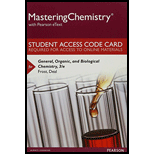
Concept explainers
To determine:
The difference between a Lewis structure and a skeletal structure in terms of atoms and bonds shown in the structure.
Introduction:
The molecules of organic compounds are represented by four different ways namely, Lewis structure, skeletal formula, condensed structural formula, and ball-and-stick model.
Lewis structures show all atoms, bonds, and lone pairs of atoms in the molecule. It helps in predicting the molecular geometry and shows the connectivity of atoms in a molecule whereas; skeletal structure is a graphical representation which shows the bonds between the carbon atoms in the form of lines in two dimensions.
Trending nowThis is a popular solution!

Chapter 4 Solutions
Mastering Chemistry with Pearson eText -- Standalone Access Card -- for General, Organic, and Biological Chemistry (3rd Edition)
- Classify each of the following hydrocarbons as alkanes, alkenes, or alkynes. (a) C12H24 (b) C7H12 (c) C13H28arrow_forwardExplain the process of interpreting skeletal structures for positively and negatively charged carbon atoms ?arrow_forwardplease draw the condensed structural formula of the following compoundsarrow_forward
 Introductory Chemistry: A FoundationChemistryISBN:9781337399425Author:Steven S. Zumdahl, Donald J. DeCostePublisher:Cengage Learning
Introductory Chemistry: A FoundationChemistryISBN:9781337399425Author:Steven S. Zumdahl, Donald J. DeCostePublisher:Cengage Learning Chemistry: Principles and ReactionsChemistryISBN:9781305079373Author:William L. Masterton, Cecile N. HurleyPublisher:Cengage Learning
Chemistry: Principles and ReactionsChemistryISBN:9781305079373Author:William L. Masterton, Cecile N. HurleyPublisher:Cengage Learning Chemistry for Today: General, Organic, and Bioche...ChemistryISBN:9781305960060Author:Spencer L. Seager, Michael R. Slabaugh, Maren S. HansenPublisher:Cengage Learning
Chemistry for Today: General, Organic, and Bioche...ChemistryISBN:9781305960060Author:Spencer L. Seager, Michael R. Slabaugh, Maren S. HansenPublisher:Cengage Learning Chemistry: An Atoms First ApproachChemistryISBN:9781305079243Author:Steven S. Zumdahl, Susan A. ZumdahlPublisher:Cengage Learning
Chemistry: An Atoms First ApproachChemistryISBN:9781305079243Author:Steven S. Zumdahl, Susan A. ZumdahlPublisher:Cengage Learning ChemistryChemistryISBN:9781305957404Author:Steven S. Zumdahl, Susan A. Zumdahl, Donald J. DeCostePublisher:Cengage Learning
ChemistryChemistryISBN:9781305957404Author:Steven S. Zumdahl, Susan A. Zumdahl, Donald J. DeCostePublisher:Cengage Learning





